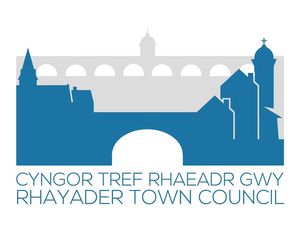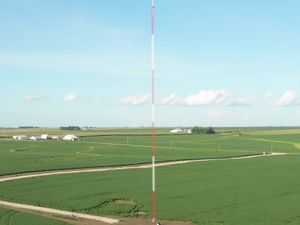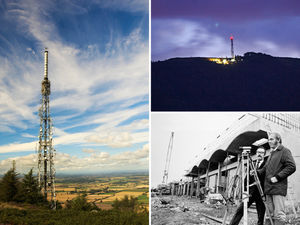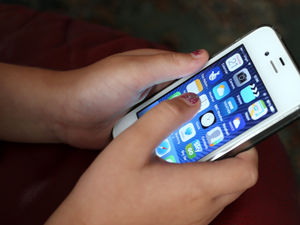How today's partial solar eclipse could be visible in parts of Shropshire
If you are lucky and it is not cloudy you might get to see a tiny partial eclipse of the sun in the western parts of Shropshire this evening.
While parts of the USA will be plunged into darkness as the moon travels between the earth and the sun, Wales and the west of Shropshire could get to see the moon take a nibble out of the sun's disk at sunset.
The moon's full shadow stops in the Atlantic ocean but the partial shadow is expected to stretch for many miles further than that at sunset. About two to 10 per cent of an eclipse is expected in Wales and west England.
A spokesperson for the Met Office said it's going to be very marginal on the Shropshire region but "might be worth a go" at sunset.
The spokesperson said it will be "very marginal in your area between the sun setting and the eclipse starting.
"From a weather perspective there will be cloud and rain pushing through your area today, there is a chance there could be some breaks in the cloud later at around the time of sunset, however cloud to the west may obstruct sunset.
"So in summary, it is very marginal but could be worth a go just in case you’re lucky."
Astronomers say everywhere west of a line from Fowey in Cornwall to Northumberland might just get a view of the Moon biting the edge of the Sun as it disappears over the horizon. But you will have to be high up to see it as the sun will be low in the horizon.
Shropshire Astronomical Society tweeted to say that on Monday, a partial eclipse could be visible from western parts of the UK, right before sunset. They advise always using approved solar glasses when observing the sun. Looking directly at the sun can damage eyesight.
BBC weather presenter Simon King says the best chance of seeing a partial solar eclipse is in the Western Isles. He tweeted on X: "Will you get to see the partial #SolarEclipse in the UK? Mostly no. Best chance is if you're in the Western Isles. Look out (only if you've got those glasses) to the setting Sun with clear view of the horizon..."
Any eclipse should begin at about 7.55pm, last three minutes and end five minutes later depending on where you are.
The total solar eclipse will plunge much of North America into darkness, turning the day skies into night. The cosmic event will see flares of the Sun's corona appear like a diamond ring in the sky.
Planets and comets may even be visible to the naked eye, and the eclipse could disrupt communications back on Earth.
A total solar eclipse happens when the Moon completely covers the Sun, and observers are within the darkest part of the Moon's shadow.
Areas covered by partial shade witness a partial eclipse, and this is what some lucky skygazers might see in the UK.
Professor Don Pollacco, from the University of Warwick's Department of Physics, said that from Glasgow about 12 per cent of the Sun will be obscured at around 8pm (BST).
Under clear conditions, people in Edinburgh could see a 6 per cent obscuration.
Dr Edward Bloomer, senior astronomer at the Royal Observatory Greenwich, said the UK is only going to get "a small grazing" of the eclipse in the west and north of the country.
Liverpool will only see a maximum of 3.1 per cent coverage at 7.57pm when the Sun is basically right on the horizon - the window is very small as the start and end times are 7.55pm and 8pm.
Belfast will be treated to more of an eclipse with a maximum of 28.1 per cent coverage at 8.10pm.
However, the Sun will be very low on the horizon, and the window is 7.55pm until 8.14pm.
The phenomenon itself will last two hours, with the eclipse starting in North America shortly after 2pm EDT (7pm BST).
The path of totality - meaning where the total solar eclipse will be fully visible - will start shortly after 11am local time in Mazatlan, Mexico.
From Mexico the total eclipse will last 4.5 minutes, and while this does not seem long, the maximum eclipse length possible is about 7-8 minutes.
Prof Pollacco, who is travelling to the US to view the total solar eclipse, said: "Total eclipses of the Sun are amazing and feel quite magical.
"From the right vantage point, you can see the Moon shadow rushing towards you at 1,000 miles an hour as totality approaches.
"When almost obscured as the Sun's light shines through valleys on the Moon's limb, you see the famous Baily's Beads (beads of sunlight emerging from the eclipse shadow) and, when the final valley is lit up, the Diamond Ring (which appears as a faint corona around the Sun, as a glittering ring).
"At this time, turning off the sunlight has effects high up in the Earth's atmosphere, which may impact communications, and produce the strange shadow bands on the ground - making the ground swirl around as you look at it."
As always, the usual rules about not looking directly at the Sun apply.
However, experts say the eclipse can be viewed safely through real solar eclipse glasses - not 3D glasses or anything similar.
But the safest, cheapest and arguably the most convenient way to view the event is by pinhole projection - make a hole in a piece of card, hold it under the Sun, and hold a piece of paper behind the card.
Using this method, people should be able to see the shape of the Sun projected on to the paper, taking away the need to look directly at the Sun.
Prof Pollacco warned: "With no protection you will at best damage your eyes, or you could blind yourself."
Total solar eclipses occur every 18 months but the visibility path of seeing the full total eclipse is only around 80 miles, so if you are not located within that track it will not be visible.
The next total eclipse of the Sun visible from the UK is in 2090.
There is another in 2026 that is visible in northern Spain, tracking up to Iceland.





